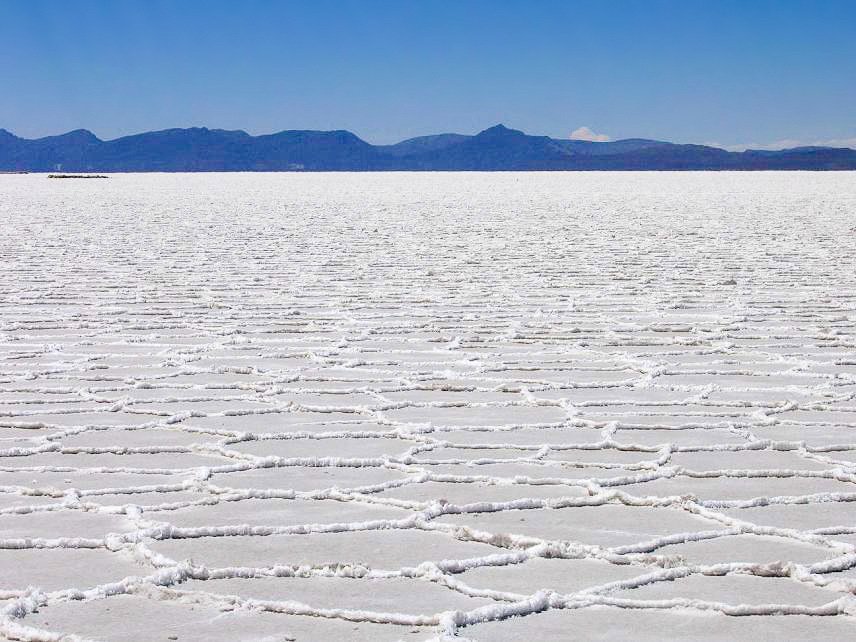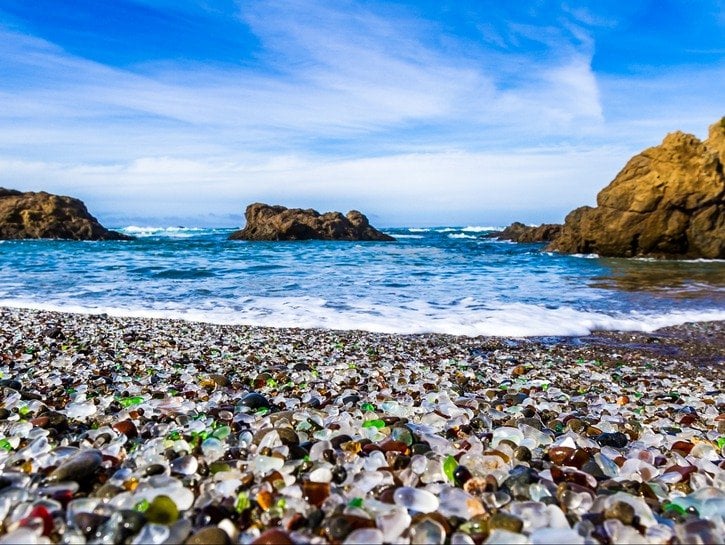It’s no secret that people have been captivated by the beauty and elegance of crystals and glass for centuries. From their ability to reflect and refract light to their unique shapes and colors, these materials have always held a special place in our imagination. In fairy tales, we see references to beautiful crystalline palaces, glass shoes, and other enchanting items, which further highlights their allure. The idea of a crystalline or glassy space is truly exciting, as it offers the opportunity to step into a world filled with breathtaking beauty and wonder. Whether it’s a glittering palace or a whimsical garden filled with crystal trees, the thought of discovering these magical places is sure to inspire wonder and imagination.
Explore the captivating glassy and crystalline locations around the world and be enchanted by their beauty.
1. Salar de Uyuni, South America

Salar de Uyuni, located in southwest Bolivia, is a unique and stunning natural wonder. It is the largest salt flat in the world and was formed from the remnants of the ancient salt lake called Lago Minchin. The salt flat is now covered by a thick layer of salt with an exceptional flatness and is characterized by seasonal pools of brine. During dry weather, the area appears as an endless expanse of white, but when the rainy season arrives, it transforms into a magnificent natural mirror. The rainwater, unable to drain, covers the surface of the salt flat and reflects the sky and its many wonders, including the colors, clouds, and other elements that speckle the sky, including flocks of flying flamingos that are commonly seen here. This stunning landscape creates the illusion of an endless world and forms the largest natural mirror on Earth, which can even be seen from space.
2. Pamukkale, Turkey

If you’re a fan of infinity pools, Pamukkale is the perfect destination for you with its 17 naturally formed infinity pools. The tranquil, glass-like water in these pools seems to extend endlessly, creating a serene atmosphere. The region is characterized by crystal clear limestone walls that enhance the beauty of the hot springs. The clear aquamarine water, surrounded by fluffy travertines, attracts visitors who love nature. The water that flows from the springs contains carbonate minerals that accumulate and form terraces, creating a stunning display of white and blue hues. During the day, the terraces can look like gleaming slabs of marble or even ice, which is surprising given the temperature of the hot springs, which can range from a warm 35°C to an extremely hot 100°C.
3. Glass Beach (California/ Newfoundland and Labrador)

The beach near Fort Bragg in California is a unique and colorful place, covered with an abundance of sea glass. The colorful glass stones were created as a result of local residents dumping various forms of waste, including glass, appliances, and even vehicles, into a coastal area north of the town for many years. Another example is the Glassy Beach located near the town of Springdale in Newfoundland and Labrador, Canada. This beach is covered with smooth pieces of broken glass in a rainbow of colors. These pieces are believed to have been washed up on shore by the waves, and they are safe to walk on with bare feet. There are several other beaches throughout Canada where you can find similar sea glass.
4. Hot springs in Yellowstone National Park, Wyoming

The Yellowstone National Park in the United States is renowned for its more than 10,000 hot springs and geysers. Some of these feature stunning colors that appear almost artificial. The colors are produced by algae in the water, which is so clear and still that it can be difficult to spot. The colors, combined with the stillness and clarity of the water, give the springs a sparkling, almost jewel-like quality. Some of the most enchanting and brilliantly colored water bodies in the park include the Morning Glory Pool, the Grand Prismatic Spring, and the Norris Cistern Spring. The Yellowstone is one of the most inspiring natural wonders and a top tourist destination in the United States.
5. Ice Caves

Ice caves can be found in the extremely cold regions of the world, including Iceland, Alaska, and Austria. These caves are lined with large amounts of year-round ice, with some parts of the caves remaining below 0°C. The ice in the caves takes on various shapes and forms, creating natural sculptures. Under the right temperature, light, and conditions, these caves can be incredibly beautiful. The shiny ice reflects and refracts light, filling the caves with mysterious, azure hues and creating an amazing monochromatic chiaroscuro effect. It’s as if the traveler is passing through an exotic glass arcade. The largest ice cave is located in the village of Werfen near Salzburg in Austria, but there are also several others in the area, including the Eisriesenwelt. Iceland is home to the Skaftafell and Vatnajokull ice caves, among others. The Mendenhall Ice Caves in Alaska are equally beautiful but also extremely dangerous.
6. Lake Huron, North America

Lake Huron is one of the five Great Lakes of North America and is a freshwater lake located on the border between Canada and the United States. The lake was formed at the end of the last ice age, when continental glaciers melted and eventually formed the lake. Thousands of ships have sunk in Lake Huron, as well as the other four Great Lakes, since the 17th century. Some of these shipwrecks can still be seen in the shallow waters of Lake Huron. From above the surface of the water, it is possible to see the wrecks clearly through the clear and still water.
7. Cave of the Crystals, Mexico

The Cave of the Crystals or the Giant Crystal Cave in Naica, Mexico, is known for its stunning selenite crystalline formations. Despite its name, it is one of the few caves in the world that truly lives up to its name. However, much of the cave remains unexplored due to the intense heat that makes it difficult to stay inside for more than ten minutes. The cave features massive beams of crystal jutting out from the floor, as well as perfectly-faceted blocks on the ground. Sadly, the formation of these beautiful crystals has ceased due to a drop in temperature in the cave. Furthermore, the existing crystals are also deteriorating in the air and may eventually disappear, existing only in documentation captured by the Naica Project.
8. Five-Flower Lake, China

The Wuhua Lake, also known as the Five Flower Lake, located in Juzhaigou Valley in Sichuan, China, is a breathtaking natural wonder. It is renowned for its stunning water, which is abundant in calcium carbonate and hydrophytes, giving the lake a mesmerizing, multi-colored appearance. The lake is also home to several fallen tree trunks that run across the lake bed, creating unique patterns in shades of green, blue, blackish green, light yellow, and more, all visible through the crystalline water. The lake is surrounded by colorful plants and flowers, adding to its beauty. It is fed by underground streams from the Long Lake, which further intensifies its colors, making it look like a shimmering gem during the peak seasons.
9. Gloss Hills, Oklahoma

The Gloss Hills, also referred to as the Glass Mountains, located in northwestern Oklahoma, are made up of mesas and buttes formed from layers of light-colored gypsum. This gypsum often takes the form of selenite crystals that are abundant in the mesas, creating a shimmering effect as if pieces of broken glass are sticking out of the hills. This is how it got its name from early settlers. There are similar Glass Mountains found in various parts of the world such as California, Oregon, Utah, etc., dotted with mineral crystals.
10. Mirror Lakes

The Mirror Lakes are known for their still and clear waters that create an almost perfect reflection of their surroundings, including hills, trees, birds, and clouds in the sky. This creates a stunning and picturesque sight.
While the name “Mirror Lakes” might seem unique, these types of lakes can actually be found in various locations across the world. Some of these include California, Tuftonboro in New Hampshire, New York, Ohio, Wallowa and Clackamas Counties in Oregon, Utah, Wisconsin, and Winter Haven in Florida. There is also a set of Mirror Lakes in New Zealand and a lake named “Mirror Lake” in Argentina. These lakes are typically situated in areas with low wind and minimal human disturbance, resulting in their serene and mirrored appearance. Other examples of such lakes include the Manasarovar in Tibet and Lake Huron in North America.
CONCLUSION
There are many other breathtaking bodies of water around the world that showcase clear views. For example, there are lakes in Montana that offer clear views of the bottom and ice-skating rinks in Sweden and Montana that freeze so quickly that the plants and rocks beneath the ice can be seen. However, these stunning natural wonders are becoming cloudier and losing their shine due to factors such as an increasing population, pollution, and rising temperatures. It is crucial that we begin taking care of these treasures that nature has provided for us and take responsibility for preserving them for ourselves and future generations to enjoy.






